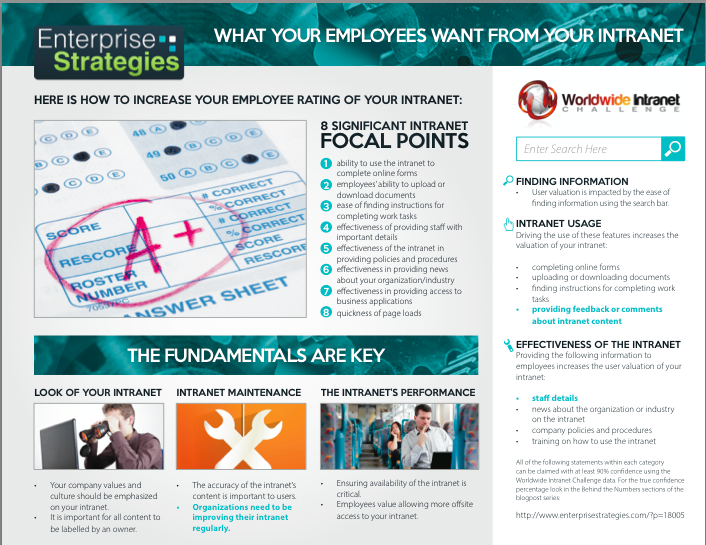Co-Author Tyler Sauerteig
In partnership with the Worldwide Intranet Challenge, we’ve applied econometric principles to the results of over 200 intranet surveys and… statistically pinpointed which intranet attributes most impact a user’s perception of their intranet.
This second post in this seven week series is focused on the data analysis of “Information Finding” factors — specifically, how a user’s valuation of their intranet is impacted by the ease of finding information on it.
The Great Navigation Menus vs. Search Debate
For years, intranet thought leaders, practitioners and nerds (self included) have wrangled with the best way to enable users to optimally find information on the intranet. I have heard many strong arguments for navigation and search alike.
The Case for Menus
The best arguments in favor of menus generally center around the importance of information architecture (if you are unsure about what this is then you can find the ia definition here) and proclaim card sorting as the only real way of knowing what your users actually expect to find where. Information architecture, according to Wikipedia, is “the the art and science of organizing and labeling websites, intranets, online communities and software to support usability and findability.” Menus are both a primary set of labels and also the vehicle that takes a user to and from sets of organized information on your site. Card sorting is “a simple technique in user experience design where a group of subject experts or ‘users.’ however inexperienced with design, are guided to generate a category tree or folksonomy.” In other words, it is a process that facilitates asking a subset of users to explain in plain language where they expect to find information on their intranet. This makes sense–organize your intranet in a way that makes sense to your users and they will be able to optimally find the information on it.
 Free Download: What Your Employees Want From Your Intranet
Free Download: What Your Employees Want From Your Intranet
In this download, you will find the following information:
- Ways to increase your employees’ rating of your company’s intranet
- How to invest your intranet redesign money to get the biggest return
- Key intranet fundamentals to ensure employee engagement
The Case for Search
The best arguments in favor or search are rooted in perceived cost avoidance and human psychology. Can a subset of users sitting in a conference room posting sticky notes on a whiteboard ever really identify the best way for all 80,000 people in your company to find information on the intranet? And if they can, how many users and how many hours would it take to get a defendable result? Sounds like a lot of people’s time (and as a result company money) being spent. Fair points. Additionally, aren’t we forgetting something — people are lazy. And while this does not apply to all people, and can instantiate itself in varying degrees, would anyone really argue that today’s intranet users expect to find everything effortlessly and now? Google it — case in point.
Our Findings
With 95% confidence we conclude that:
- an increase in ranking “the intranet search helps me find the information I need” results in a higher valuation of the respondents intranet as a whole.
- the impact for the same question related to menus was statistically insignificant.
So what exactly does this mean? Let’s start with what this does not mean. This does not mean that menus themselves are insignificant, purposeless or should be done away with. It also does not mean that search is the answer to everything. You have to remember what our study is trying to prove and that is which intranet attributes most positively (or negatively) impact users’ perceptions of their intranet. In other words,
If you are going to redesign your intranet with the intent of improving users’ perception, where should you spend your money?
I would suggested you invest more time and money on search optimization than refining menu navigation. According to our findings, you will get a bigger positive (user perception) return on your investment.
Do you agree?
Where would you spend your time and money — search optimization or refining menu navigation? I genuinely look forward to your comments. I think there is a good discussion to be had here.
To see the details on how we came to the above conclusions, please grab a (strong) cup of coffee and read the following section.
Behind the Numbers
The econometric issues of specification error, serial correlation, and heteroskedasticity are all accounted for within our information finding data set.
Statement Coefficient P-Value
I can find information I need on the intranet 0.484 0.023
The intranet menus help me find the information I need -0.208 0.216
The intranet search helps me find the information I need 0.007 0.958
I know where I am in the intranet hierarchy -0.009 0.927
Adjusted- R²: 0.078
Statement Coefficient P-Value
The intranet menus help me find the information I need 0.081 0.467
The intranet search helps me find the information I need 0.211 0.050
I know where I am in the intranet hierarchy -0.012 0.899
Adjusted- R²: 0.059
As you can see, we included 2 charts of information based on the category to better show the statistics about finding information on the intranet. Although the adjusted-R² does drop from 7.8% of the variance in the valuation of the intranet being described by the independent variables (the statements) to 5.9%, I believe the second set of information may be of more value on what to focus on in your intranet build.
In the first equation including all four statements in the category we find that:
- With 97.5% confidence we conclude that a one ranking increase in information finding on the intranet results in an increase in the valuation of your intranet.
- We also see that our intranet menus and search are insignificant with the intranet menus helping you find the information being negative. Therefore, for the second chart I have chosen to omit (leave out) the statement “I can find the information I need on the intranet” in order see more of the importance being your menus or your search as an information finding function.
When looking at the 3 statements we find that the intranet search function is statistically significant in our study.
- With 95% confidence we conclude that an increase in the intranet search helping you find the information you need in the ranking system results in a higher valuation on your intranet as a whole. As for menus the number shifted from negative to positive, but is not significant. However, this shows that the statement on finding the information that you need was picking up a lot of the impact of the other two statements. The intranet hierarchy in both equations appears to be very insignificant in your ultimate valuation of your intranet.
Interpretation Of The Coefficient (Using The Second Set Of Results):
- When looking at only the information finding statements, given that your answer to the WIC statement “The intranet search helps me find the information I need” was ranked one rating higher (better) in the WIC ranking system for that statement, the way that you were ranked in the rating of your intranet in the valuation question, “In general, I would rate the intranet as” was, on average, .211 ranks higher (better), holding all other variables constant.
We hope that you have learned what to target in your information finding capabilities of your intranet. Stay tuned for our next post in the series about what statistically can be concluded in the statement category of “How often you use the intranet to…”


